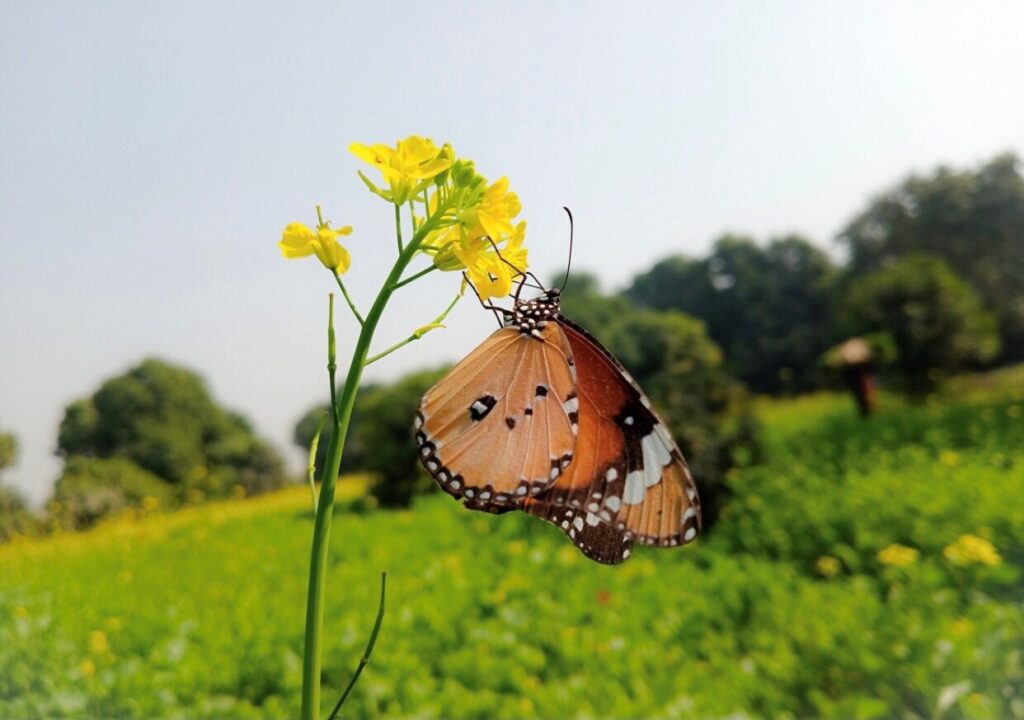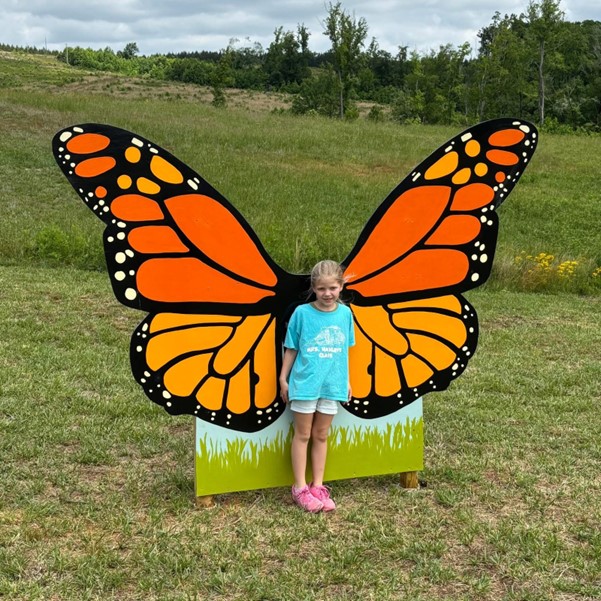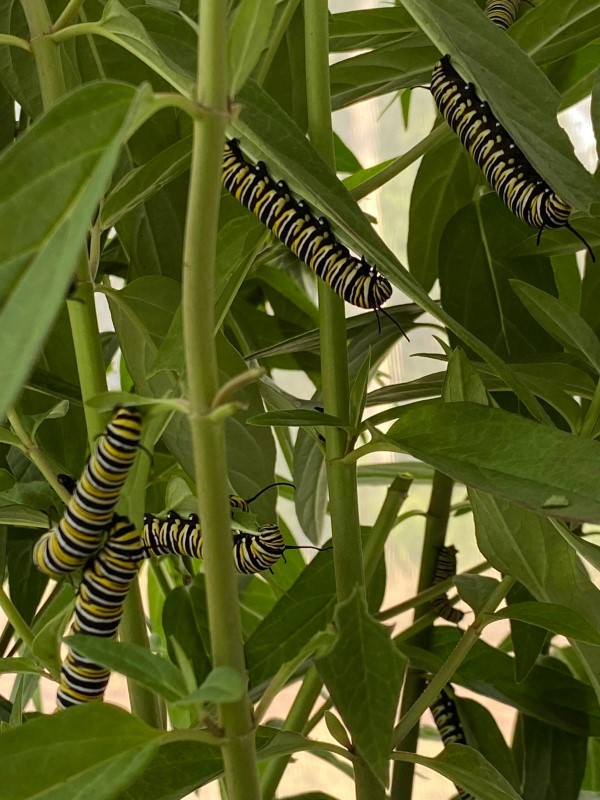Raising butterflies is magical no matter the species — but there’s something truly special about the Monarch experience.

1. A Real Connection to Nature
• Monarch caterpillars eat only milkweed, which means you get to raise them on a living, growing plant — not a cup of artificial diet (see the video below).
• This gives you a front-row seat to real garden ecology, pollinator awareness, and plant-insect interaction.
• Painted Ladies are usually raised on a paste-like artificial diet in a cup — quick and convenient, but far removed from nature.
2. A “Luckier” Lifecycle
• Painted Ladies can feel like an “assembly line” experience: caterpillars in a cup, butterflies out in a week, and done.
• Monarchs offer a longer, more thoughtful journey — from caterpillar to chrysalis to butterfly, often over 2–3 weeks.
• Watching a Monarch chrysalis shift from jade green to transparent gold is truly breathtaking — and worth the wait.
3. Conservation You Can See
• Monarch populations are in decline, and raising them helps support their survival.
• By planting milkweed and raising Monarchs, you’re making a real difference in pollinator conservation.
• Painted Ladies aren’t threatened, and raising them doesn’t have the same ecological impact.
⸻
In short:
Painted Ladies are fun. Monarchs are unforgettable.
With Monarchs, you raise more than a butterfly — you grow a connection to the natural world, and become part of something bigger.
To download the Classroom Comparison Chart, click here.
The monarch butterfly migration is one of the most remarkable natural phenomena in the world. Monarchs (Danaus plexippus) undertake a multi-generational migration spanning thousands of miles across North America. Their journey is unique because no single butterfly completes the entire round trip—rather, it takes four to five generations to complete the full cycle.

The Migration Cycle
Spring Migration (Northward Journey)
• In March and April, monarchs begin their journey north from Mexico and Southern California, where they have spent the winter in dense forest groves.
• These butterflies lay eggs on milkweed plants across the southern U.S. before dying.
• The next generation hatches, matures, and continues the journey north.
Summer Generations
• Over the next few months (May to August), multiple generations are born in the U.S. and Canada.
• Each new generation moves farther north, following the growth of milkweed, their host plant.
• These summer monarchs live for about 2-6 weeks and continue reproducing.
Fall Migration (Southward Journey)
• The last generation of the year, known as the “super generation,” is born in late summer (August-September).
• Unlike their short-lived ancestors, these butterflies can live up to 8 months.
• They do not reproduce immediately; instead, they focus on flying up to 3,000 miles south to their wintering grounds.
Overwintering in Mexico and California
• Monarchs from eastern North America migrate to the mountains of central Mexico (specifically, the oyamel fir forests in Michoacán).
• Monarchs from western North America migrate to coastal California, clustering in groves of eucalyptus, cypress, and pine trees.
• They remain in their overwintering sites until the weather warms up in February or March, when the cycle begins again.
Threats to Monarch Migration
• Habitat Loss: Deforestation in Mexico and urban expansion in North America threaten critical habitats.
• Declining Milkweed Populations: Monarchs depend on milkweed to lay eggs, but widespread herbicide use has drastically reduced its availability.
• Climate Change: Unseasonal temperatures, severe storms, and droughts disrupt migration timing and survival rates.
How to Help Monarch Butterflies
• Plant native milkweed and nectar-rich flowers.
• Avoid using pesticides that harm butterflies and caterpillars.
• Support conservation efforts to protect overwintering sites.
• Participate in citizen science projects to track monarch populations.
Monarch migration is both fragile and awe-inspiring. Scientists continue to study this phenomenon, and conservationists work to ensure future generations can witness this incredible journey.
The monarch butterfly migration is one of the most remarkable natural phenomena in the world. Monarchs (Danaus plexippus) undertake a multi-generational migration spanning thousands of miles across North America. Their journey is unique because no single butterfly completes the entire round trip—rather, it takes four to five generations to complete the full cycle.
The Migration Cycle
Spring Migration (Northward Journey)
• In March and April, monarchs begin their journey north from Mexico and Southern California, where they have spent the winter in dense forest groves.
• These butterflies lay eggs on milkweed plants across the southern U.S. before dying.
• The next generation hatches, matures, and continues the journey north.
Summer Generations
• Over the next few months (May to August), multiple generations are born in the U.S. and Canada.
• Each new generation moves farther north, following the growth of milkweed, their host plant.
• These summer monarchs live for about 2-6 weeks and continue reproducing.
Fall Migration (Southward Journey)
• The last generation of the year, known as the “super generation,” is born in late summer (August-September).
• Unlike their short-lived ancestors, these butterflies can live up to 8 months.
• They do not reproduce immediately; instead, they focus on flying up to 3,000 miles south to their wintering grounds.
Overwintering in Mexico and California
• Monarchs from eastern North America migrate to the mountains of central Mexico (specifically, the oyamel fir forests in Michoacán).
• Monarchs from western North America migrate to coastal California, clustering in groves of eucalyptus, cypress, and pine trees.
• They remain in their overwintering sites until the weather warms up in February or March, when the cycle begins again.
Threats to Monarch Migration
• Habitat Loss: Deforestation in Mexico and urban expansion in North America threaten critical habitats.
• Declining Milkweed Populations: Monarchs depend on milkweed to lay eggs, but widespread herbicide use has drastically reduced its availability.
• Climate Change: Unseasonal temperatures, severe storms, and droughts disrupt migration timing and survival rates.
How to Help Monarch Butterflies
• Plant native milkweed and nectar-rich flowers.
• Avoid using pesticides that harm butterflies and caterpillars.
• Support conservation efforts to protect overwintering sites.
• Participate in citizen science projects to track monarch populations.
Monarch migration is both fragile and awe-inspiring. Scientists continue to study this phenomenon, and conservationists work to ensure future generations can witness this incredible journey.
LILESVILLE, N.C., April 3, 2025 (SEND2PRESS NEWSWIRE) — Whimsical Wings Farms, a leader in butterfly conservation and pollinator education, is proud to announce a breakthrough in plant shipping: a patented box designed to safely deliver one-gallon milkweed plants. Paired with the farm’s engaging Monarch Butterfly Lifecycle Kit, the innovation supports nationwide habitat restoration efforts and hands-on environmental education.

Read the Press Release here.
As spring blooms, many of us are eager to tidy up our lawns. But before you mow down that lush patch of clover or reach for weed killer, here’s something important to consider:
That clover isn’t a weed — it’s a lifeline.

Pollinators Are in Trouble — Your Lawn Can Help
Pollinators like bees, butterflies, and other beneficial insects are facing an alarming decline. According to conservation groups, species like the Monarch butterfly and native bumblebees are dangerously close to extinction. The culprits?
- Pesticide use
- Habitat destruction
- Loss of food sources, especially in early spring
Clover and wildflowers provide much-needed nectar when other plants haven’t yet bloomed. By letting these plants thrive, you’re offering a sanctuary to creatures vital to our food system and ecosystems.
A Simple, Powerful Way to Make a Difference
This spring, you can turn your yard into a safe haven for pollinators by taking three simple steps:
- Skip the pesticides – Even “natural” ones can be harmful to pollinators.
- Let your clover grow – Clover is not only beautiful, but rich in nectar.
- Welcome the wild – Embrace a bit of nature’s messiness. It’s buzzing with life.
When you do this, you’re not just helping bees and butterflies – you’re also improving your soil, increasing biodiversity, and reducing the need for chemical lawn care.
Your Yard Can Be a Small Patch of Hope
In a world that’s increasingly challenging for wildlife, your backyard can be part of the solution. Every flower matters. Every patch of green makes a difference.
This spring, make a bold, beautiful choice:
Plant kindness. Let it bloom.
#SaveTheBees
#PollinatorFriendly
#NoPesticides
#CloverLawn
#WildlifeGardening
#OrganicLawnCare
#MonarchButterfly
#EcoFriendlyYard
#BackyardHabitat
#LetItGrow
Artificial pollination is not replacing natural pollinators but rather supplementing them in situations where they are declining or insufficient. Natural pollinators, such as bees, butterflies, and birds, play an irreplaceable role in ecosystems, supporting biodiversity and agricultural production. However, due to habitat destruction, pesticide use, climate change, and diseases, many pollinator populations are in decline.


Butterflies taste with their feet! Their sense of taste is 200 times more powerful than a human being. Once the butterfly lands on the plant, it can immediately determine if it’s good to eat. It also helps them determine if the plant is suitable for their babies to hatch and grow.
“I see trees of green, Red roses too.
I see them bloom, For me and you
And I think to myself, What a wonderful world”
– Lyrics to “A Wonderful World” by Louis Armstrong

This song always makes me think of beautiful yards. But a beautiful yard is in the eyes of the beholder. Personally, I love my “white” yard. Lots of people see clover or other wild flowers in the yard as a weed and/or foe. But did you know that these wild flowers are what the pollinators survive on in the spring? The garden flowers have not yet bloomed, but the pollinators are already out and about, and need sustenance. That’s where these lovely flowers come into play and are a staple in the feeding of pollinators.
I know people love a lush green yard. But do you know the consequences of having one? If you eradicate the clover and other wild flowers from your yard with chemicals, not only are you killing off the much needed food for all the pollinators, but you are also killing the insects that live in the soil as well as your local song birds that feed off these insects.
Instead of using chemicals, EMBRACE the wild flowers growing in your yard. You will be amazed with all the creatures that will enjoy them. And in turn, you will get to enjoy knowing you have a pollinator friendly yard and will be rewarded with these wonderful whimsical winged creatures. What a wonderful world, indeed.
You hate mosquitos. I hate mosquitos. EVERYONE hates mosquitos.

Because of this, millions of people use companies to help eradicate these unwanted pests. But did you know that you’re killing more than just mosquitos? You are killing all the good insects too, including our beloved pollinators.
The wind – no matter how faint – can also transfer the chemicals that are being sprayed. As they’re being sprayed onto certain areas of your home (typically plants), the wind can carry them to plants that you may not want to be poisoned. It’s impossible to fully contain the spray and what plants it hits.
These chemical sprays kill the mosquitos, but they also kill our beloved caterpillars and butterflies. The reason being, the spray will hit the plants which both the caterpillars and butterflies eat. So not only will they be poisoned and die, but any bird or other creature that eats the insect will be poisoned as well.
Great alternatives for keeping mosquitos at bay – remove any standing water in your yard and purchase plants! Plants are great for helping to keep mosquitos at bay. Some top plants are citronella, lavender, and mint – to name a few. Additional types of plants that can repel mosquitos can be found at: https://www.countryliving.com/gardening/garden-ideas/g2479/plants-that-repel-mosquitoes/
Also, don’t forget to use mosquito spray on you! If you use the spray on your body, which you can easily wash off, this too will keep you protected, but won’t harm the environment.
So enjoy your yard this summer, mosquito free, while also enjoying our beloved butterflies!
